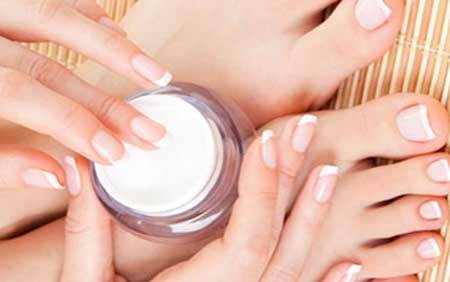Fungal nail infection refers to a large family of dermatomycosis caused by fungal parasites of the genus dermatophytes( Tinea Mentagrophytes, Epidermophyton floccosum, Candida fungi and mold mycelia).
It is their active deleterious effect on the nail plates that leads to pathological destruction of their structure.
Contents
Main genesis and risk factors, photo
- 4 Types and principle of treatment of fungal infection of nails
- 4.1 External treatment of nail fungus: ointments, creams and varnishes
- 4.2 Folk methods
- 5 Prevention of foot nail fungus
Main genesis and risk factors, photo
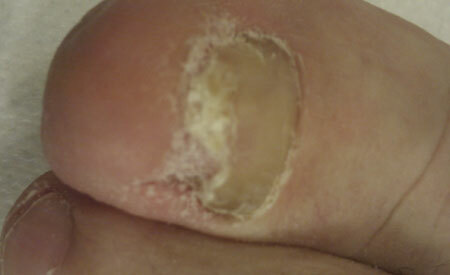
The reasons for the appearance of the nail fungus on the big toe can be very diverse, but the main one is a huge lifeindividuality fungal parasite. It is capable of instantly penetrating, adapting and developing in favorable conditions for it.
Penetrate into the microscopic cracks of corns and calluses that occur mainly in the area of the big toe. Especially if the shoes "do not breathe" or do not match the size of the foot.
But even this fact does not always indicate the mandatory development of fungal infection. Healthy immunity itself can cope with the infection. People with different background pathologies fall into the risk zone:
- of endocrine diseases( in particular SD);
- recurrent scaly lichen( psoriasis);
- of varicose vascular disease;
- AIDS-indicator pathologies;
- pathology of metabolic processes;
- of the eczema and dermatitis;
- skin infections.
An additional source of infection, which can be attributed to the main reason - contact with the carrier of the infection or with personal items of its use. The most likely reasons include contacts with patients in sports centers, swimming pools or public baths.
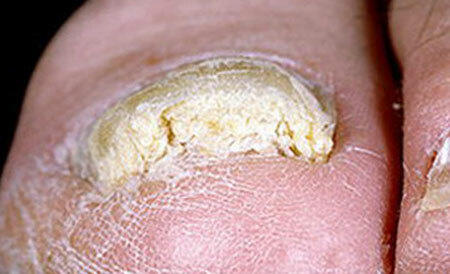
Nail fungus on the big toe, photo
Transmission of the fungus can occur when trying on other people's things and shoes, in beauty parlors where the processing of tools is not properly carried out, etc.
Increases the likelihood of fungus:
- neglect of personal hygiene;
- synthetic underwear and substandard shoes;
- excessive obesity and addiction to alcohol.
The elderly are the most vulnerable to fungal disease. With age, physiological changes occur in the structure of the nail plates, they thicken, blood circulation is disturbed, the protective acid balance changes, which creates favorable conditions for the penetration and development of the disease.
Stages of development of the nail fungus on the legs
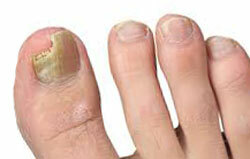 The subungnal environment is the optimal place for the growth of the fungal mycelium, since it contains a large number of nutrients. As a result of the action of microorganisms on the tissue structure of the subungual bed, a certain enzyme is released, which destroys the tissue itself and the strong fibrillar proteins of the plate.
The subungnal environment is the optimal place for the growth of the fungal mycelium, since it contains a large number of nutrients. As a result of the action of microorganisms on the tissue structure of the subungual bed, a certain enzyme is released, which destroys the tissue itself and the strong fibrillar proteins of the plate.
An expanded empty zone is formed, ideally suited for the development of filamentous mycelial fungi, which gradually destroys the surface and structure of the nail plate.
The development of destructive changes in the nail caused by a fungal infection is due to three stages( stages).
- The initial stage of is the type of normotrophic lesion. There is a central, or edge nail destruction. It shows up with spots and stripes on the limited parts of the plate.
- The middle stage of is hypertrophic changes. It is characterized by sealing and changing the configuration of the nail plate with the spread of the process over its entire area.
- The stage of degeneration of ( hypotrophic) - an inflammatory reaction of the peri-oral fenula is noted. Infection affects adjacent tissues. Various infections join, the nail plate is destroyed and crumbled.
Symptoms of nail injury of the thumb
fungus In the initial stage of infection, the presence of fungal lesions by any signs is not manifested. Sometimes there may be minor itching, redness and burning in the area of the big toe.
With the growth of the mycelium, the symptomatology becomes obvious. The nail structure changes, it becomes brittle and dull. On the plate appear white, or yellow hue spots and stripes.
Sometimes the presence of a fungus confirms a thickened nail plate ingrown into corners inside the roller. This indicates its deformation under the influence of fungal infection, which is typical for the big toes.
Appears:
- tenderness when walking;
- swelling and redness of the thumb;
- sometimes purulent discharge from the corners of the plate.
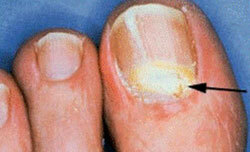
Symptoms of nail damage
Various variations in nail plate lesions are explained by the action of a different type of pathogen. Dermotophyte fungi are characterized by bands or spots of yellow color located along its edges or center.
Moldy mushrooms stain the plate almost black. The swelling of the nail roller, the formation of silvery scales on it, the yellowing of the sides of the nail and their separation from the bed, provokes the action of yeast fungi.
In the process of life, fungi release toxins, destructive not only on the nail plates. The development of fungal infection contributes to the penetration of toxins into the lymphatic canal system, provoking:
- an increased sensitivity of the organism, manifested by allergic rashes;
- disorders of the functions of the gastrointestinal tract;
- intoxication symptoms.
Types and principle of treatment of fungal infection of nails
 Spores of parasitizing fungi perfectly and instantly adapt in the upper stratum corneum of the nail plate, gradually penetrating into the interior of the matrix.
Spores of parasitizing fungi perfectly and instantly adapt in the upper stratum corneum of the nail plate, gradually penetrating into the interior of the matrix.
Therefore, the principles of treating the nail fungus on the big toe are built according to the system of local-external and systemic influence. With a strictly individual approach, due to signs of pathology and an indicator of the state of internal systems and organs of the patient.
The basis of the principle is a complex method of treatment with the use of pulse therapy, systemic, bacterial and external therapy or a simultaneous combination of several techniques. Pulse - therapy. Based on a discontinuous scheme of long-term treatment with antimycotic drugs.
Scheme includes:
- Oral administration of the drug "Rumikoz" or its analogs - weekly intake 2 times / day for 200 mg. Repeat in 3 weeks. Duration of treatment - three courses.
- Daily for the entire period of treatment - "Lamisil" or analogue 1 time / day 250 mg. The agent is able to suppress the development of any pathogenic fungi.
Systemic treatment of increases the chance of completely getting rid of the infection. It is used for a significant lesion with obvious signs of structural changes in the nail plates of the big toes.
The most popular:
- "Terbinafine" and "Itraconazole" - from 250 to 400 mg./day individual course( not less than 4 weeks).
- "Diflucan" or analogues - 2 times / week for 150 mg. Course - two months.
With the addition of infection, treatment is supplemented by bacterial therapy. A course of vitamin complexes and immunomodulating agents is recommended.
- Inexpensive and effective drugs for the treatment of nail fungus, a review of
The effectiveness of drug treatment is based on a cumulative principle, when the required concentration of drugs, provides reliable protection for a long time after discontinuation of treatment.
Therefore, it is very important to strictly adhere to the regimen and the recommended interval.
External treatment of nail fungus: ointments, creams and varnishes
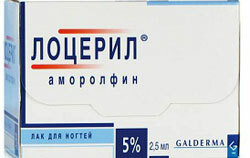
varnish Lotseril Amorolfin
In addition to treatment, at the initial stages of infectious processes in the nail plates of the thumbs, various methods of external influence on the infection are used:
- Antimycotic properties of lacquer in the form of Loceril Amorolfin or Batrofen. Once a week on the pre-cleaned nail plate, apply a medical varnish in two layers. The duration of the course is from three months to a year.
- Antimycotic serum "Mikozan" - applied to the affected area 1 time / day until it is completely restored.
- "Dimexide" lotions are used for resorption of the inflammatory processes of the nail roller.
- Treatment of nail plates with salicylic, benzoic and lactic acid, tar and sulfur preparations.
- Sulfur and salicylic ointment for treatment of the nail of the thumb are applied up to 3 times / day. The course of application depends on the condition of the nail.
The appointment should be given by a physician.
With considerable damage to the plate, it is most advisable to remove it. Ointment containing urea is applied to the affected area in the form of a compress for the whole night. Or use for this purpose a special medical plaster.
The nail plate softens, it is pruned and the removal of fragments of fragments followed by treatment with antiseptics. Until a new nail is grown, the area is smeared with a solution or ointment "Exoderyl" or other antimycotic ointments twice a day.
Folk methods

As alternative methods:
iodine treatment - in the form of rubbing the affected area 2 times / day until complete recovery.
Lemon - during a week to the infected nail fix with cellophane and bandage a slice of lemon. Treatment with lemon has been known since ancient times and shows good results.
Hydrogen Peroxide - the effectiveness of treating nail fungus with hydrogen peroxide is proven by time. Before attaching the compress with peroxide( cotton swab) to the nail plate, it must be steamed in hot water with the addition of several crystals of copper sulphate( vitriol) and drained.
The duration of the compress is up to half an hour, until the plate brightens. Softened areas are scraped and lubricated with any antifungal cream.
Prevention of foot nail fungus
In addition to excluding all causative factors, the main rule of disease prevention:
- proper hygienic care for feet and toes;
- daily water cleansing procedures;
- application of essential oil, lotion and creams, to moisturize the skin;
- correct filing and timely removal of ingrown corners of the nail and keratinized skin.
If nevertheless it was necessary to visit at a party like strangers slippers, or bare feet in public places, treat the legs with an antifungal agent.
If you can not purchase it, wipe your feet with a solution of citric acid or squeezed lemon juice. Strengthen immunity, eat right, play sports and this will not leave a chance for the development of fungal infection.


